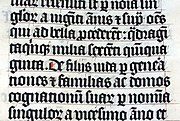Scribal abbreviation
Scribal abbreviations (sigla) were abbreviations used by ancient and medieval scribes writing in Latin.
History

The use of abbreviations is due, in part, to exigencies arising from the nature of the materials employed in the making of records, whether stone, marble, bronze, or parchment. Lapidaries, engravers, and copyists were under the same necessity of making the most of the space at their disposal. Such abbreviations, indeed, were seldom met with at the beginning of the Christian era when material of all kinds was plentiful and there was consequently no need to be sparing in the use of it. By the third or fourth century, however, it had grown to be scarce and costly, and it became the artist's aim to inscribe long texts on surfaces of somewhat scanty proportions.
The Romans possessed an alphabet known by the name of "Notae Tironienses", which served the same purpose as our modern systems of stenography. Its use necessitated a special course of study and there is still much uncertainty as to the significance of the characters employed. Inscriptions cut in stone are the most frequent use of abbreviations. At certain late periods - for example in Spain in the Middle Ages, this custom becomes abused to such an extent as to result in the invention of symbols which are undecipherable.
Scribal abbreviations have entered the news in the twenty-first century because the recently revived Scottish Parliament needs to find out what the old codes of Scottish law written in Latin say. Those who have learned Latin without having also learned Latin palaeography find these abbreviations incomprehensible. At a recent count, there were well over fourteen thousand abbreviations.

Forms
In the best period of epigraphy certain rules were strictly observed. The abbreviations in common use fell under two chief heads:
- The reduction of the word to its initial letter;
- The reduction of a word to its first letters in a bunch or to several letters taken at intervals in the body of the word and set side by side.
The latter arrangement was almost conclusively Christian, whereas in non-Christian inscriptions the number of letters left in the abbreviation was more or less limited, yet no intermediate letter was omitted.
Occasionally a phrase which had become stale by constant use and had grown into a formula, was rarely found in any other form than that of its abbreviation (examples: D.M. for Diis Manibus, IHS for Jesus, R.I.P. for requiescat in pace).
Another form of abbreviation consisted in doubling the last consonant of the word to be shortened as many times as there were persons alluded to, e.g. AVG for Augustus, AVGG for Augusti duo. Stone cutters however, soon began to take liberties with this rule, and, instead of Putting COSS for Consulibus duobus, invented the form CCSS. Still, when there was occasion to refer to three or four people this doubling of the last consonant gave way of necessity, in abbreviations, to the simple sign of the plural. A horizontal line over a letter or set of letters was also much used, and was destined indeed, to become almost universal in the Middle Ages. The undulating line, or one curved at each end and rising in the middle only came into use at a comparatively late period.
Abbreviation signs consisted of tildes, macrons, and marks that resembled apostrophes above letters. Other modifications included cross-bars and extended strokes. Such abbreviations were mostly for prefixes and verb, noun, and adjectival suffixes. They are not to be confused with the forms of abbreviation that do not use unusual marks, some of which have survived, such as i.e. and loc. cit. (viz, however, is actually an abbreviation for "videlicet", vi + an abbreviation mark resembling the letter z or the number 3).
Besides scribal abbreviations, in old texts one will find some variant characters including digraphs, the long s, and the half r, which are difficult enough to understand. The pair of characters "u" and "v", as well as the pair "i" and "j", were not distinguished from each other in medieval writing. Nowadays, variant letters and the scribal abbreviations are systematically replaced with the full Latin spellings by most publishers who still print Latin works, and the confusable letters are rendered such that the characters "j" and "v" are not used for vowels.
One remaining scribal abbreviation is the ampersand, for the Latin (or French) word, et, meaning "and". There were several other ways of writing the word et; one, derived from the ancient Latin Tironian note, resembles an Arabic numeral "7", though at x-height. Although in the nineteenth century, the way to write an ampersand was taught in primary schools, it is no longer mandated.
Technically, the ampersand (&) is a ligature. When printing with movable type appeared in the fifteenth century, founders made many different ligatures to go with each set of type they produced. Such sets were called "record type". Manuscripts of ancient Greek, a language that entered Western Europe with the Renaissance, used similar abbreviations which had to be converted into ligatures as well. This was to imitate the scribal form of writing to which the readership was accustomed. But the scribal abbreviations did not apply to the vernacular languages of Europe. As works were published in these languages, a development that is often imagined as being due to the Reformation, scribal abbreviations disappeared.
![]() This article incorporates text from a publication now in the public domain: Herbermann, Charles, ed. (1913). Catholic Encyclopedia. New York: Robert Appleton Company.
This article incorporates text from a publication now in the public domain: Herbermann, Charles, ed. (1913). Catholic Encyclopedia. New York: Robert Appleton Company. {{cite encyclopedia}}: Missing or empty |title= (help)
